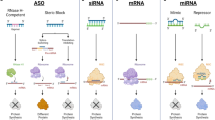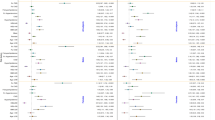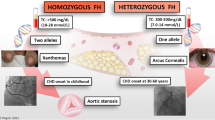Abstract
Arachidonate 12/15-lipoxygenase (12/15-LOX) has been implicated in the pathogenesis of atherosclerosis, but with contradicting results. The aim of this study was to investigate the association of two polymorphisms in ALOX15 and the risk of coronary artery disease (CAD) in a Chinese Han population. A total of 519 unrelated CAD patients and 608 unrelated control subjects of the Chinese Han population were recruited in the case-control study. Two tagSNPs, rs7217186:T>C and rs2619112:G>A, were selected and genotyped by polymerase chain reaction-restriction fragment length polymorphism (PCR-RFLP). The carriers of the C allele (the CC homozygote and the CT heterozygote) of rs7217186:T>C and the carriers of the A allele (the AA homozygote and the GA heterozygote) of rs2619112:G>A displayed elevated odds ratios (ORs) for CAD compared with the TT homozygotes and GG homozygotes, respectively, after adjusting for other potential confounders including age, sex, body mass index, systolic blood pressure, diastolic blood pressure, glucose, triglyceride, total cholesterol, high-density lipoprotein cholesterol, low-density lipoprotein cholesterol, and smoking status (adjusted odds ratio [OR] = 3.2, 95% confidence interval [CI]: 1.335–7.665, P = 0.009 and adjusted OR = 3.5, 95% CI: 1.343–9.330, P = 0.011). In stratified analyses, after adjusting those aforementioned confounders, the CC and CT genotypes of rs7217186:T>C were associated with a greater risk of CAD in subjects <60 years (adjusted OR = 5.7, 95% CI: 1.557–21.097, P = 0.009) and in females (adjusted OR = 9.3, 95% CI: 1.048–82.213, P = 0.045). For rs2619112:G>A, subjects (<60 years) carrying the A allele had a greater risk of CAD than the GG homozygotes (adjusted OR = 4.9, 95% CI: 1.215–19.547, P = 0.025); the male carriers of A allele also had a greater risk (adjusted OR = 3.5, 95% CI: 1.136–11.006, P = 0.029). In summary, the present study shows that after adjustment for other confounding CAD factors, rs7217186:T>C and rs2619112:G>A of ALOX15 are associated with increased risk of CAD in this Chinese Han population.
Similar content being viewed by others
References
Ross R (1999) Atherosclerosis: an inflammatory disease. N Engl J Med 340:115–126
Ylä-Herttuala S, Palinski W, Rosenfeld ME, Parthasarathy S, Carew TE, Butler S, Witztum JL, Steinberg D (1989) Evidence for the presence of oxidatively modified low density lipoprotein in atherosclerotic lesions of rabbit and man. J Clin Invest 84:1086–1095
Palinski W, Rosenfeld ME, Ylä-Herttuala S, Gurtner GC, Socher SS, Butler SW, Parthasarathy S, Carew TE, Steinberg D, Witztum JL (1989) Low density lipoprotein undergoes oxidative modification in vivo. Proc Natl Acad Sci USA 86:1372–1376
Chisolm GM, Steinberg D (2000) The oxidative modification hypothesis of atherogenesis: an overview. Free Radic Biol Med 28:1815–1826
Steinberg D (2002) Atherogenesis in perspective: hypercholesterolemia and inflammation as partners in crime. Nat Med 8:1211–1217
Kuhn H, Thiele BJ (1999) The diversity of the lipoxygenase family. Many sequence data but little information on biological significance. FEBS Lett 449:7–11
da Silva EL, Abdalla DS, Terao J (2000) Inhibitory effect of flavonoids on low-density lipoprotein peroxidation catalyzed by mammalian 15-lipoxygenase. IUBMB Life 49:289–295
Cathcart MK, Folcik VA (2000) Lipoxygenases and atherosclerosis: protection versus pathogenesis. Free Radic Biol Med 28:1726–1734
Cyrus T, Praticò D, Zhao L, Witztum JL, Rader DJ, Rokach J, FitzGerald GA, Funk CD (2001) Absence of 12/15-lipoxygenase expression decreases lipid peroxidation and atherogenesis in apolipoprotein e-deficient mice. Circulation 103:2277–2282
George J, Afek A, Shaish A, Levkovitz H, Bloom N, Cyrus T, Zhao L, Funk CD, Sigal E, Harats D (2001) 12/15-Lipoxygenase gene disruption attenuates atherogenesis in LDL receptor-deficient mice. Circulation 104:1646–1650
Hiltunen T, Luoma J, Nikkari T, Ylä-Herttuala S (1995) Induction of 15-lipoxygenase mRNA and protein in early atherosclerotic lesions. Circulation 92:3297–3303
Ylä-Herttuala S, Rosenfeld ME, Parthasarathy S, Glass CK, Sigal E, Witztum JL, Steinberg D (1990) Colocalization of 15-lipoxygenase mRNA and protein with epitopes of oxidized low density lipoprotein in macrophage-rich areas of atherosclerotic lesions. Proc Natl Acad Sci USA 87:6959–6963
Kühn H, Heydeck D, Hugou I, Gniwotta C (1997) In vivo action of 15-lipoxygenase in early stages of human atherogenesis. J Clin Invest 99:888–893
Reilly KB, Srinivasan S, Hatley ME, Patricia MK, Lannigan J, Bolick DT, Vandenhoff G, Pei H, Natarajan R, Nadler JL, Hedrick CC (2004) 12/15-Lipoxygenase activity mediates inflammatory monocyte/endothelial interactions and atherosclerosis in vivo. J Biol Chem 279:9440–9450
Bolick DT, Orr AW, Whetzel A, Srinivasan S, Hatley ME, Schwartz MA, Hedrick CC (2005) 12/15-Lipoxygenase regulates intercellular adhesion molecule-1 expression and monocyte adhesion to endothelium through activation of RhoA and nuclear factorkappaB. Arterioscler Thromb Vasc Biol 25:2301–2307
Wölle J, Welch KA, Devall LJ, Cornicelli JA, Saxena U (1996) Transient overexpression of human 15-lipoxygenase in aortic endothelial cells enhances tumor necrosis factor-induced vascular cell adhesion molecule-1 gene expression. Biochem Biophys Res Commun 220:310–314
Natarajan R, Pei H, Gu JL, Sarma JM, Nadler J (1999) Evidence for 12-lipoxygenase induction in the vessel wall following balloon injury. Cardiovasc Res 41:489–499
Nakao J, Ooyama T, Ito H, Chang WC, Murota S (1982) Comparative effect of lipoxygenase products of arachidonic acid on rat aortic smooth muscle cell migration. Atherosclerosis 44:339–342
Natarajan R, Rosdahl J, Gonzales N, Bai W (1997) Regulation of 12-lipoxygenase by cytokines in vascular smooth muscle cells. Hypertension 30:873–879
Taylor AM, Hanchett R, Natarajan R, Hedrick CC, Forrest S, Nadler JL, McNamara CA (2005) The effects of leukocyte-type 12/15-lipoxygenase on Id3-mediated vascular smooth muscle cell growth. Arterioscler Thromb Vasc Biol 25:2069–2074
Shen J, Kuhn H, Petho-Schramm A, Chan L (1995) Transgenic rabbits with the integrated human 15-lipoxygenase gene driven by a lysozyme promoter: macrophage-specific expression and variable positional specificity of the transgenic enzyme. FASEB J 9: 1623–1631
Shen J, Herderick E, Cornhill JF, Zsigmond E, Kim HS, Kühn H, Guevara NV, Chan L (1996) Macrophage-mediated 15-lipoxygenase expression protects against atherosclerosis development. J Clin Invest 98:2201–2208
Trebus F, Heydeck D, Schimke I, Gerth C, Kuhn H (2002) Transient experimental anemia in cholesterol-fed rabbits induces systemic overexpression of the reticulocyte-type 15-lipoxygenase and protects from aortic lipid deposition. Prostaglandins Leukotrienes Essent Fatty Acids 67:419–428
Merched AJ, Ko K, Gotlinger KH, Serhan CN, Chan L (2008) Atherosclerosis: evidence for impairment of resolution of vascular inflammation governed by specific lipid mediators. FASEB J 22: 3595–3606
Biselli PM, Guerzoni AR, de Godoy MF, Pavarino-Bertelli ÉC, Goloni-Bertollo EM (2008) Vascular endothelial growth factor genetic variability and coronary artery disease in Brazilian population. Heart Vessels 23:371–375
Zak I, Sarecka B, Krauze J (2008) Synergistic effects between 561A>C and 98G>T polymorphisms of E-selectin gene and hypercholesterolemia in determining the susceptibility to coronary artery disease. Heart Vessels 23:257–263
Assimes TL, Knowles JW, Priest JR, Basu A, Borchert A, Volcik KA, Grove ML, Tabor HK, Southwick A, Tabibiazar R, Sidney S, Boerwinkle E, Go AS, Iribarren C, Hlatky MA, Fortmann SP, Myers RM, Kuhn H, Risch N, Quertermous T (2008) A near null variant of 12/15-LOX encoded by a novel SNP in ALOX15 and the risk of coronary artery disease. Atherosclerosis 198:136–144
Wittwer J, Bayer M, Mosandl A, Muntwyler J, Hersberger M (2007) The c.-292C>T promoter polymorphism increases reticulocytetype 15-lipoxygenase-1 activity and could be athero-protective. Clin Chem Lab Med 45:487–492
McCaskie PA, Beilby JP, Hung J, Chapman CM, McQuillan BM, Powell BL, Thompson PL, Palmer LJ (2008) 15-Lipoxygenase gene variants are associated with carotid plaque but not carotid intimamedia thickness. Hum Genet 123:445–453
Hersberger M, Müller M, Marti-Jaun J, Heid IM, Coassin S, Young TF, Waechter V, Hengstenberg C, Meisinger C, Peters A, König W, Holmer S, Schunkert H, Klopp N, Kronenberg F, Illig T (2009) No association of two functional polymorphisms in human ALOX15 with myocardial infarction. Athrosclerosis 205:192–196
Puddu P, Cravero E, Puddu GM, Muscari A (2005) Genes and atherosclerosis: at the origin of the predisposition. Int J Clin Pract 59:462–472
Wittwer J, Marti-Jaun J, Hersberger M (2006) Functional polymorphism in ALOX15 results in increased allele-specific transcription in macrophages through binding of the transcription factor SPI1. Hum Mutat 27:78–87
Marenberg ME, Risch N, Berkman LF, Floderus B, de Faire U (1994) Genetic susceptibility to death from coronary heart disease in a study of twins. N Engl J Med 330:1041–1046
Author information
Authors and Affiliations
Corresponding author
Additional information
K.Z. and Y.W. contributed equally to this work.
Rights and permissions
About this article
Cite this article
Zhang, K., Wang, Yy., Liu, Qj. et al. Two single nucleotide polymorphisms in ALOX15 are associated with risk of coronary artery disease in a Chinese Han population. Heart Vessels 25, 368–373 (2010). https://doi.org/10.1007/s00380-009-1223-5
Received:
Accepted:
Published:
Issue Date:
DOI: https://doi.org/10.1007/s00380-009-1223-5




